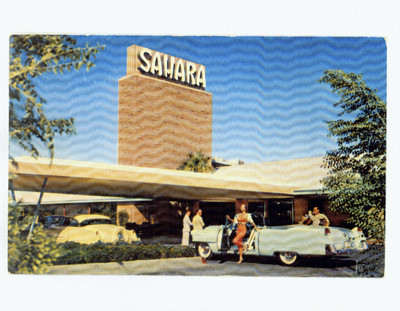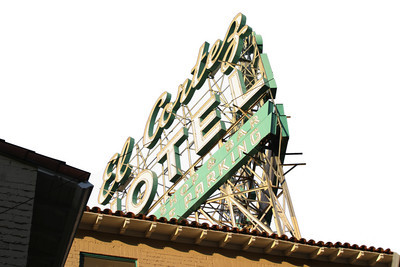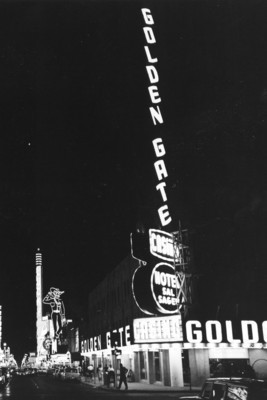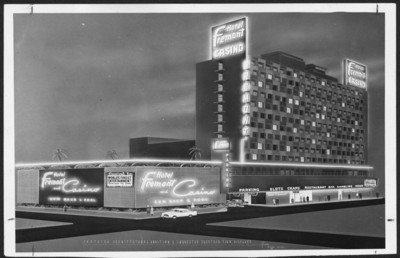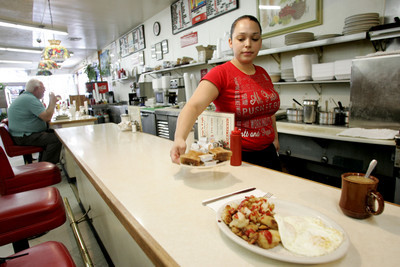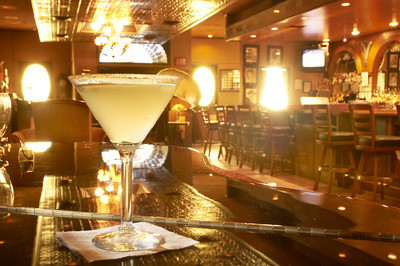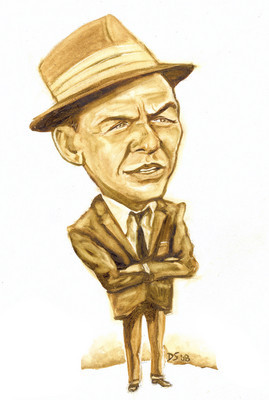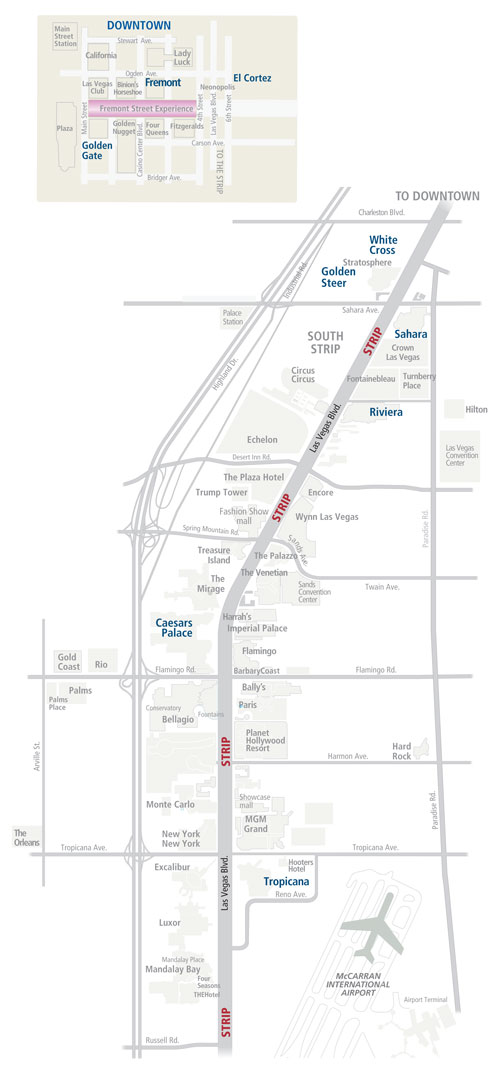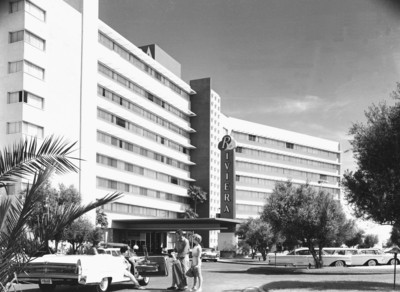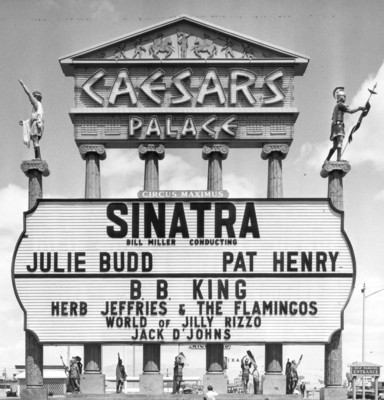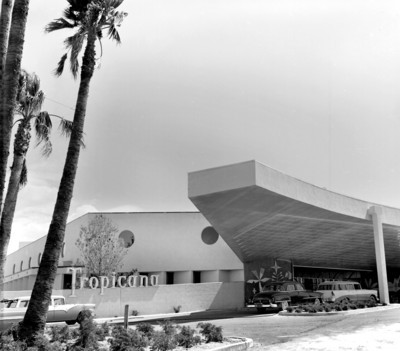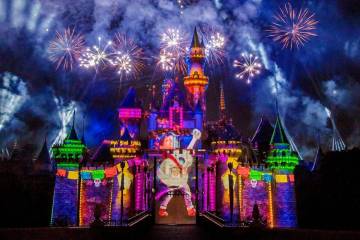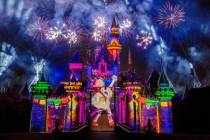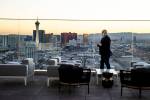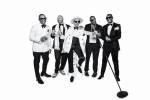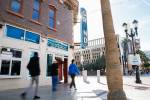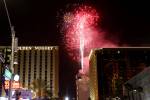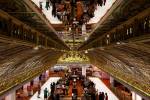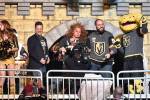Lost Vegas
The history of Las Vegas has an unusual adversary: The people who own its landmarks.
"New and improved!" has pretty much been our only urban plan since mobster Benjamin "Bugsy" Siegel opened his extravagant Flamingo Hotel in 1946. Virtually nothing built between then and the Rat Pack '60s -- the Desert Inn, the Sands, the Dunes, the Stardust -- still stands. Every time Las Vegas explodes, it seems, it implodes first.
Even the Flamingo destroyed the last vestige of its storied past. The motel rooms by the pool -- including Bugsy's Oregon Suite, with its secret getaway staircase -- were replaced by the Hilton Corp. with two towers in the mid-'90s.
"There's a lot of interest in Las Vegas when we were the entertainment capital of the world and we had Frank Sinatra, Dean Martin and Sammy Davis Jr. performing here," said Lynn Zook, historian for the Friends of Classic Las Vegas preservation society. "And it is sad that, for the most part, you can't see where they performed, you can't hang out where they hung out, because the places aren't here anymore."
What follows is a guide to the rare exceptions to that rule -- places where classic Las Vegas still reigns out of reach of a wrecking ball.
At least for now.
1. GOLDEN GATE
1 Fremont St.
Even when the Rat Pack roamed Vegas, the Golden Gate was ancient. Opened as the Hotel Nevada in 1906, it featured the first working telephone line in Las Vegas. (The phone number? One.)
Most of the ornate wooden fixtures that aren't original date back to renovations in 1931, when the hotel was renamed Sal Sagev (Las Vegas spelled backward), and 1955, when the Golden Gate began operating as a casino underneath the Sal Sagev. (The entire hotel assumed the Golden Gate's name in 1974.)
Come for the inexpensive shrimp cocktails, hiked in price from the popular 99 cents to a scandalous $1.99 earlier this year. (Players club card holders still pay 99 cents.) But stay for the nostalgia. Playing single-deck blackjack while the piano player croons will make a guy feel underdressed without a tux.
2. FREMONT
200 Fremont St.
Despite a $3 million 1977 renovation, the Fremont looks pretty much as it did when it opened as Nevada's tallest building in 1956, launching the downtown high-rise trend. (Its roof was the prime atomic test-watching real estate.)
Then, as now, the Fremont catered to locals. But it distinguished itself from the surrounding Western-themed carpet joints with a sleek, modern flavor imparted by El Rancho/Sands architect Wayne McAllister.
"It is a gem of our downtown gems," said Atomic Age Alliance founder Mary Margaret Stratton. "If it could only have been past the Fremont Street Experience balcony. I think it's time to start thinking about demolishing that and putting the street neon closer to its original Glitter Gulch look."
In 1959, 15-year-old Wayne Newton and his brother, Jerry, played their first Las Vegas gig in the Carnival Lounge here as the Newton Brothers from Phoenix.
"The permit said we couldn't be there when we weren't working," Wayne Newton said. "So as we came out of our dressing room, we had to either go outside or the coffee shop -- if it wasn't busy.
"It was strange," Newton recalled. "I would pass the keno lounge and see actors that I recognized. But I was never allowed to approach them."
3. EL CORTEZ
600 Fremont St.
The silver lining to downtown's continued economic strife is how effectively it prevents owners from destroying the classic Vegas mystique of their properties. (The one glaring exception is the Golden Nugget, which was completely made over during 1984, 1990 and 2006 renovations.)
Other than the tower behind it, the El Cortez hasn't changed much since opening in 1941. The facade is completely recognizable. And, despite $20 million in recent upgrades, the casino floor is like a smoky time machine. Strolling through it recalls the day when Las Vegas' first race wire operated here.
"It was a ticker that transmitted the results," said resident hotel trivia expert Kenny Epstein, who guessed its location as "upstairs in an office somewhere."
"These race results would come over," Epstein said. "Then they would transmit them over the telephone to the sports books, and then they'd re-create the race."
Siegel was sent from Los Angeles to Las Vegas in 1945 to forcibly replace this wire with the Mafia's own Trans-American Publishing and News Service. (He used its profits to buy an interest in the El Cortez and, later, help finance construction of the Flamingo.)
You might even encounter some living history on your stroll. Jackie Gaughan, who owned the hotel from 1963 until earlier this year, still makes his home at the El Cortez.
4. WHITE CROSS DRUGS
1700 Las Vegas Blvd. South
Nowhere was daytime showgirl-watching better than at the Liberty Cafe, now the Tiffany, which opened here in 1964 (when the White Cross relocated from downtown to make room for the Four Queens).
"You couldn't eat too much, because you had to go back and dance," said Betty Bunch, who high-kicked it at the Sahara, Riviera, Desert Inn, Aladdin, Dunes and Caesars Palace.
Bunch said nearly every female dancer on the Strip frequented this drugstore because of the cosmetics.
"They had a huge selection," she said. "They carried Dorothy Gray's eye salve, which was a tiny little pot of stuff you were supposed to put on your eyes. But there was no lip gloss in those days, so we used it for that."
5. GOLDEN STEER
308 W. Sahara Ave.
The oldest surviving Las Vegas steakhouse opened in 1958. Steve Rossi dined here regularly with his stand-up partner, Marty Allen, while opening for Sinatra at the Sands.
He describes the main room -- which still boasts the original booths and paneling -- as "like going to your dining room to eat."
The restaurant's Web site claims Sinatra, Martin and Davis as "regular" customers. But Rossi doubts the claim, adding that Sinatra and Martin rarely hung out together.
"It was mostly Frank, Sammy and Peter Lawford -- if anyone," Rossi said. "After the show, Dean would usually go home or to his room. He was part of the Rat Pack only from performing, because Sinatra was never his leader.
"Dean thought he was a bigger star than Sinatra."
6. SAHARA
2535 Las Vegas Blvd. South
The Sahara -- unveiled in 1952 on the site of the former Club Bingo -- is commonly called "the last Rat Pack hotel." While portions of 1960's "Ocean's Eleven" were filmed here, the Riviera also was used. And the Rat Pack never played either hotel as a collective.
Still, Sinatra, Martin, Davis and Joey Bishop all played the Sahara, and whomever was in town could be counted on to gather in the lounge to heckle comedian Don Rickles.
"It was just an incredible time with those guys," said Steve Lawrence, an unofficial Rat Packer much younger than the other performers.
"They loved life, they loved what they did," Lawrence said. "Everybody had a great time watching them. But I think they had the best time of all."
Most of the Sahara has been overhauled. Since 1999, the gaming area feels more like Busch Gardens -- with NASCAR fans and a roller coaster running incessantly through. But the Alexandria and Tunis towers -- with their rooftop turrets and wrought-iron screens -- have hardly been touched since going up in the '60s. The presidential suite (room 2542 in Alexandria) is where Elvis Presley allegedly loved Ann-Margret tender while shooting "Viva Las Vegas" in 1963.
7. RIVIERA
2901 Las Vegas Blvd. South
Before the Fremont opened, the Riviera's nine-story north tower was Nevada's tallest building. The casino quickly earned another historic distinction by paying Liberace $50,000 per week to headline, an outrageous sum in 1955, when the hotel opened. (The pianist had been playing the New Frontier for much less, but supposedly didn't want to leave.)
Much of today's Riviera is original, including the north tower's first nine stories and the Versailles Theater -- although the once-largest Vegas venue was called the Clover when Liberace tinkled here.
Later headliners included George Burns, Red Skelton, Louis Armstrong and various Rat Pack members. In 1969, Martin purchased 10 percent of the hotel, which named a bar in his honor: Dino's Den. Martin's famous association with the hotel ended in 1972, after he announced he would do only one show a night -- like his pal Sinatra at Caesars Palace.
"When he went to his dressing room after the show, all of his clothes were thrown out in the hallway, and there was a note on the door," said fellow entertainer Rossi.
According to Rossi, the note -- from hotel owner Eddie Torres -- read: "Nobody tells the boss they're gonna do one show! You're outta here!"
8. CAESARS PALACE
3570 Las Vegas Blvd. South
Most of the hotel is new, and high rollers occupy the space where Sinatra once serenaded Circus Maximus showroom audiences. But there are elements recognizable from opening day 1966: the fountain out front, the main entryway, the 14-story Centurion tower, the Cleopatra Lounge and the sunken circular casino lounge.
"Caesars is one of the few hotels that's kind of still there," said Lawrence, who -- with wife Eydie Gorme -- performed dozens of times at the Circus Maximus and closed it in 2000.
"It was an extraordinarily beautiful hotel," Lawrence said. "First of all, that long driveway, which I think every hotel should have on the Strip, was very impressive."
That driveway wasn't quite long enough for Shecky Greene, however. Not long after Caesars opened, the comic plowed his car into the fountain. According to fellow comedian Buddy Hackett's frequent retelling of the story, police waded in and Greene instructed them: "No spray wax."
Incidentally, there can hardly be a better example of Vegas' official disregard for its past than the response of a Caesars publicist asked to provide additional details: "I'm sorry, but I don't know who Shakey Greene is."
9. TROPICANA
3801 Las Vegas Blvd. South
The old casino building was gutted in 1977 to build the Tropicana's first tower. But the two wings of motel rooms branching off from the new casino were here when the "Tiffany of the Strip" opened in 1957.
Lounging with a cocktail by the pool -- which still has swim-up blackjack -- is still a great classic Las Vegas experience, even though the pool was built in 1985. (Hey, that's old for Vegas.)
And one of the most important surviving artifacts on the Strip is here. Imported from Paris in 1959 by entertainment director Lou Walters (Barbara's dad), the "Folies Bergere" is our town's longest-running showgirl show.
Contact reporter Corey Levitan at clevitan@reviewjournal.com or 702-383-0456.



